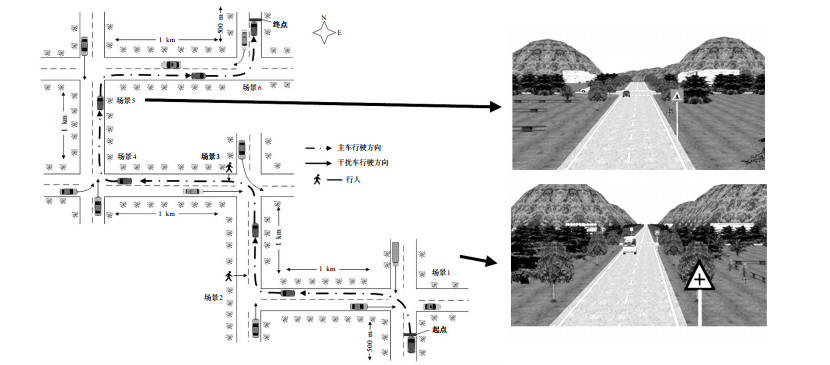A Graph Study on Turning Behaviors of Older Drivers at Unsignalized Intersections
-
摘要: 考虑到老年驾驶人存在的视觉弱化、反应能力下降等问题,有必要分析其转向行为特征。基于此,本文分析了在无信号控制交叉口情景下老年驾驶人的转向行为特征,并绘制图谱描述行为特征的时序变化。基于无信号控制交叉口的现实场景调查,搭建了具备常见冲突类型的虚拟仿真驾驶场景(包含6个无信号控制交叉口),招募符合要求的老年驾驶人与中青年驾驶人进行驾驶模拟实验,分别采集车辆行驶数据(驾驶模拟器)、眼动数据和生理心理数据分析老年驾驶人与中青年驾驶人在不同转向场景下的行为特征差异,应用图谱理论构建驾驶人转向行为图谱描述老年驾驶人与中青年驾驶人的转向行为特征时序变化。实验结果表明:老年驾驶人的速度均值为20.4 km/h、注视持续时间均值为289.47 ms、扫视幅度均值为3.51°;中青年驾驶人的速度均值为35.79 km/h、注视持续时间均值为247.94 ms、扫视幅度均值为4.56°。老年驾驶人的心率变异性时域指标(SDNN和RMSSD)与频域指标(LF/HF和TP)的值更低,表明老年驾驶人在转向过程中更加紧张。图谱显示老年驾驶人的紧张持续时间更长,并在信息获取广度上弱于中青年驾驶人。结合图谱时空差异性指标发现,这2类驾驶人的驾驶行为在左转向场景下存在显著性差异,老年驾驶人驾驶操作的稳定性与安全性较低。Abstract: Considering the vision issues and slow response of older drivers, it is therefore important to study their turning behavior. Given this fact, the turning behavior of older drivers at unsignalized intersections are studied in this paper and a graph is developed to describe the changes of their driving behaviors over the time. A virtual simulation of driving scenes (including six unsignalized intersections) with different types of conflicts are developed based on a field survey. Next, older drivers and young/middle-aged drivers who meet requirements of simulation are recruited to conduct the experiment. Data regarding vehicle operation behaviors, eye movements, and physiological and psychological condition are collected to analyze the differences of behavioral characteristics between older and young/middle-aged groups of drivers under different turning scenarios. The Graph Theory is adopted to describe the features of behaviors for older and young/middle-aged drivers. Results show that for older drivers, the average of turning velocity is 20.4 km/h, fixation duration is 289.47 ms, and saccade amplitude is 3.51°. For young/middle-aged drivers, their average speed is 35.79 km/h, 247.94 ms and 4.56°, respectively. Older drivers are more nervous during the turning process since their time domain indicators (SDNN and RMSSD) and frequency domain indicators (LF/HF and TP) are lower. The graph indicates that the time of older drivers' nervousness lasts longer than young/middle-aged drivers do, and older drivers have a lower ability to collecting different information. Finally, the spatiotemporal differences from the graphs indicate that there are significant differences between the turning behavior of the two driver groups in left-turning scenarios, and the older drivers' turning behavior show a lower level of stability and safety.
-
表 1 驾驶模拟系统数据指标
Table 1. The indicator of driving simulation system
仪器设备 数据指标 驾驶模拟器 速度(km/h), 制动踏板深度(mm), 油门踏板深度(mm), 转向盘转角(°), 加速度(m/s2) ErgoLAB生理心理仪 心电(ECG), 皮电(EDA), 肌电(EMG) i-viewHED4眼动仪 扫视幅度(°),注视时长(ms) 表 2 不同场景下车辆运行特征值与差异性分析
Table 2. Analysis of characteristic values and differences of vehicle operation in different scenarios
特征指标 驾驶人类型 场景1 场景2 场景3 场景4 场景5 场景6 Mean 中青年驾驶人 27.1 34.34 35.78 37.81 38.84 40.88 35.79 速度均值/(km/h) 老年驾驶人 13.86 20.460 19.37 21.90 24.44 22.34 20.4 P 0.001** 0.021* 0.002** 0.005** 0.036* 0.001** 中青年驾驶人 12.01 12.63 11.81 13.84 11.18 10.92 12.07 速度标准差/(km/h) 老年驾驶人 5.44 7.07 7.4 8.88 8.4 9.22 7.74 P < 0.001** 0.003** < 0.001** 0.005** 0.003** 0.001** 中青年驾驶人 0.35 0.48 0.30 0.49 0.32 0.31 0.38 加速度/(m/s2) 老年驾驶人 0.76 0.35 0.40 0.44 0.43 0.46 0.47 P 0.001** < 0.001** 0.001** 0.001** < 0.001** 0.001** 中青年驾驶人 0.6 0.84 0.47 0.53 0.37 0.71 0.59 制动踏板深度/mm 老年驾驶人 0.79 0.62 0.57 0.62 0.61 0.85 0.68 P < 0.001** < 0.001** < 0.001** 0.006** < 0.001** < 0.001** 中青年驾驶人 4.9 11.2 2.70 4.5 4.80 7.70 5.97 最早深制动时间/s 老年驾驶人 4.700 6.100 1.30 5.70 0.60 3.70 3.68 P 0.450 0.02* 0.038* 0.047* 0.001** 0.01** 注:*为在0.05水平上显著;**为在0.01水平上显著。 表 3 驾驶人眼动特征统计及差异性分析
Table 3. Statistic and difference analysis of driver's eye movement characteristics
特征指标 驾驶人类型 场景1 场景2 场景3 场景4 场景5 场景6 中青年驾驶人 216.951 244.17 245.660 255.000 255.520 270.350 注视持续时间均值/ms 老年驾驶人 331.25 284.210 263.490 314.320 302.450 241.120 P 0.272 0.341 0.789 0.433 0.525 0.592 中青年驾驶人 3.660 4.130 5.120 2.710 6.120 5.590 扫视幅度均值/(°) 老年驾驶人 2.790 3.410 3.810 4.570 3.400 3.090 P 0.838 0.491 0.615 0.297 0.328 0.340 表 4 驾驶人皮电增长率与差异性分析
Table 4. Analysis on the growth rate and difference of drivers' skin electricity
驾驶人类型 场景1 场景2 场景3 场景4 场景5 场景6 中青年驾驶人 1.09 0.7 0.56 0.72 0.69 1.05 老年驾驶人 2.06 0.77 0.93 0.83 0.94 1.14 P 0.002** 0.475 < 0.001** 0.066 0.001** 0.508 表 5 肌电频率均值及差异性分析
Table 5. Analysis of mean value and difference of EMG frequency
驾驶人类型 场景1 场景2 场景3 场景4 场景5 场景6 中青年驾驶人 268.75 268.54 269.04 266.48 269.46 267.61 老年驾驶人 267.16 266.36 268.48 267.29 267.61 268.03 P 0.465 0.324 0.897 0.613 0.544 0.816 表 6 心率变异性评价指标
Table 6. Evaluation indicator of heart rate variability
分析法 指标 指标含义 指标表征 时域分析 SDNN/ms
RMSSD/ms
PNN50/%表示全程记录期间所有N-N间期(或心动间隔)的标准差
表示相邻RR间期之差的标准差(均方根)
表示相邻心搏之差大于50 ms的个数占心搏总数的百分比衡量驾驶人的紧张程度,值越小,紧张程度越高 频域分析 LF/ms2
LF/HF
TP/ms2表示低频段0.04~0.15 Hz
表示低频带与高频带功率的比值
包括超低频、极低频、低频、高频在内的功率的总和衡量神经兴奋状态
衡量神经平衡能力
衡量机体调节能力表 7 驾驶人心电指标分析及差异性分析
Table 7. Analysis of driver's ECG indicator and difference
特征指标 驾驶人类型 场景1 场景2 场景3 场景4 场景5 场景6 中青年驾驶人 0.11 0.077 0.062 0.066 0.054 0.055 心率增长率 老年驾驶人 0.19 0.082 0.075 0.069 0.056 0.068 P 0.078 0.118 0.007** 0.042* 0.093 0.029* 中青年驾驶人 355.15 203.29 187.88 233.47 324.34 255.65 SDNN/ms 老年驾驶人 269.05 179 140.05 152.84 238.44 160.53 P 0.046* 0.136 0.002** 0.043* 0.119 0.012* 中青年驾驶人 458.61 246.61 240.04 301.7 481.26 347.74 RMSSD/ms 老年驾驶人 378.83 203.79 195.08 207.31 313.13 179.73 P 0.011* 0.068 0.006** 0.042* 0.036* 0.02* 中青年驾驶人 32.24 24.14 22.26 25.96 33.33 26.53 PNN50/% 老年驾驶人 17.74 14.79 16.73 17.13 17.85 11.15 P 0.008** 0.047* 0.032* 0.033* 0.074 0.03* 中青年驾驶人 47.11 52.52 50.36 44.53 47.02 53.28 LF/ms2 老年驾驶人 47.38 46.09 50.14 32.48 42.04 43.07 P 0.08 0.824 0.005** 0.51 0.959 0.006** 中青年驾驶人 4.61 3.74 4.2 3.57 2.77 2.8 LF/HF 老年驾驶人 1.98 1.98 2.69 2.35 3.36 1.87 P 0.072 0.639 0.045* 0.468 0.976 0.035* 中青年驾驶人 586.16 440.88 387.80 375.79 508.35 283.53 TP/ms2 老年驾驶人 98.56 120.08 106.77 436.63 140.24 209.41 P 0.368 0.262 0.009** 0.003** 0.558 0.041* 表 8 图谱构建的指标信息
Table 8. Indicator information of map construction
行为特性 特性指标 符号 数据范围 速度(Velocity)/(km/h) V 0~80 驾驶操作 加速度(Acceleration)/(m/s2) AC -9~9 制动踏板深度(Brake pedal depth)/mm BPD 0~10 视觉特性 注视时长(Fixation time)/ms FT 0~6000 扫视幅度(Saccade amplitude)/(°) SA 0~30 生理心理特性 心率(Heart rate growthrate)/bpm HR 0~150 皮电(Electrodermal activity)/us EDA 0~15 肌电(Electromyography)/mv EMG 0~5 -
[1] MAZER B, CHEN Y T, VRKLJAN B, et al. Comparison of older and middle-aged drivers' driving performance in a naturalistic setting[J]. Accident Analysis & Prevention, 2021 (161): 106343 [2] 马勇, 付锐. 驾驶人视觉特性与行车安全研究进展[J]. 中国公路学报, 2015, 28(6): 82-94. doi: 10.3969/j.issn.1001-7372.2015.06.012MA Y, FU R. Research and development of drivers visual behavior and driving safety[J]. China Journal of Highway and Transport, 2015, 28(6): 82-94. (in Chinese) doi: 10.3969/j.issn.1001-7372.2015.06.012 [3] 郭凤香, 石晨光, 李明远, 等. 老年驾驶人在交叉口的视觉特性[J]. 中国公路学报, 2018, 31(9): 150-158+219. doi: 10.3969/j.issn.1001-7372.2018.09.017GUO F X, SHI C G, LI M Y, et al. Visual characteristics of older drivers in road intersections situation based on driving simulation[J]. China Journal of Highway and Transport, 2018, 31(9): 150-158+219. (in Chinese) doi: 10.3969/j.issn.1001-7372.2018.09.017 [4] 温惠英, 区俊锋, 宋文通. 老年驾驶人交通事故严重程度影响因素分析[J]. 合肥工业大学学报(自然科学版), 2021, 44 (6): 812-817+850. doi: 10.3969/j.issn.1003-5060.2021.06.017WEN H Y, QU J F, SONG W T. Analysis of factors influencing the severity of traffic accidents by elderly drivers[J]. Journal of Hefei University of Technology(Natural Science), 2021, 44(6): 812-817+850(. in Chinese doi: 10.3969/j.issn.1003-5060.2021.06.017 [5] 菅美英, 石京. 老年驾驶员跟驰行为及影响因素研究[J]. 中国安全科学学报, 2017, 27(6): 25-30. https://www.cnki.com.cn/Article/CJFDTOTAL-ZAQK201706005.htmJIAN M Y, SHI J. Study on older drivers' car following behavior and influencing factors[J]. China Safety Science Journal, 2017, 27(6): 25-30(. in Chinese https://www.cnki.com.cn/Article/CJFDTOTAL-ZAQK201706005.htm [6] 石京, 菅美英. 老年人驾驶特性和未来中国老年人交通安全问题分析[J]. 交通信息与安全, 2014, 32(5): 20-24+35. doi: 10.3963/j.issn.1674-4861.2014.05.004SHI J, JIAN M Y. Driving characteristics of elderly people and their traffic safety problems for the future of China[J]. Journal of Transport Information and Safety, 2014, 32(5): 20-24+35(. in Chinese doi: 10.3963/j.issn.1674-4861.2014.05.004 [7] LI G, BRAVER E, CHEN L H. Fragility versus excessive crash involvement as determinants of high death rates per vehicle-mile of travel among older drivers[J]. Accident Analysis & Prevention, 2003, 35(2): 227-235. [8] FAIN M. Should older drivers have to prove that they are able to drive?[J]. Archives of Internal Medicine, 2003, 163(18): 2126-2128. doi: 10.1001/archinte.163.18.2126 [9] LUCIDI F, MALLIA L, LAZURAS L, et al. Personality and attitudes as predictors of risky driving among older drivers[J]. Accident Analysis & Prevention, 2014(72): 318-324. [10] ZHANG J, LINDSAY J, CLARKE K. Factors affecting the severity of motor vehicle traffic crashes involving elderly drivers in Ontario[J]. Accident Analysis & Prevention, 2000, 32(1): 117-125. [11] MCGWIN J G, BROWN D B. Characteristics of traffic crashes among young, middle-aged, and older drivers[J]. Accident Analysis & Prevention, 1999, 31(3): 181-198. [12] CAI Q, ABDEL-ATY M, LEE J Y, et al. Developing a grouped random parameters multivariate spatial model to explore zonal effects for segment and intersection crash modeling[J]. Analytic Methods in Accident Research, 2018(19): 1-15. [13] CLARKE D D, WARD P, BARTLE C, et al. Older drivers' road traffic crashes in the UK[J]. Accident Analysis & Prevention, 2010, 42(4): 1018-1024. [14] 徐金华, 李岩, 张玉婷. 一种挖掘交叉口事故严重程度影响因素关联特性的算法[J/OL]. 安全与环境学报. (2021-12-02)[2022-04-03]. https://doi.org/10.13637/j.issn.1009-6094.2021.1553.XU J H, LI Y, ZHANG Y T. An algorithm to mine the association rules among causes of accident severity at intersection[J/OL]. Journal of Safety and Environment. (2021-12-02)[2022-04-03]. https://doi.org/10.13637/j.issn.1009-6094.2021.1553. (in Chinese) [15] 刘志强, 周亮, 汪澎, 等. 交叉口驾驶员转向意图辨识研究[J]. 科学技术与工程, 2014, 14(17): 299-302+306. doi: 10.3969/j.issn.1671-1815.2014.17.060LIU Z Q, ZHOU L, WANG P, et al. Research of driver intention identification at intersections[J]. Science Technology and Engineering, 2014, 14(17): 299-302+306. (in Chinese) doi: 10.3969/j.issn.1671-1815.2014.17.060 [16] 薛志超, 巩渭华, 杨波, 等. 常见驾驶行为下驾驶人注意力分配特征[J]. 济南大学学报(自然科学版), 2018, 32(6): 469-475. https://www.cnki.com.cn/Article/CJFDTOTAL-SDJC201806006.htmXUE Z C, GONG W H, YANG B. Attention allocation features of drivers under common driving behaviors[J]. Journal of University of Jinan (Science and Technology), 2018, 32(6): 469-475. (in Chinese) https://www.cnki.com.cn/Article/CJFDTOTAL-SDJC201806006.htm [17] 齐凯, 张琨, 纪俐. 左右转向驾驶行为脑功能网络关联性分析[J]. 沈阳航空航天大学学报, 2019, 36(5): 42-47. doi: 10.3969/j.issn.2095-1248.2019.05.007QI K, ZHANG K, JI L. Correlation analysis of EEG functional connectivity during driving behavior: Turning left and right[J]. Journal of Shenyang Aerospace University, 2019, 36 (5): 42-47(. in Chinese doi: 10.3969/j.issn.2095-1248.2019.05.007 [18] ZHAO J, YUN M P, ZHANG H, et al. Driving simulator evaluation of drivers' response to intersections with dynamic use of exit-lanes for left-turn[J]. Accident Analysis & Prevention, 2015(81): 107-119. [19] DIGVIJAY S. P, GOPAL R. P. Response of major road drivers to aggressive maneuvering of the minor road drivers at unsignalized intersections: A driving simulator study[J]. Transportation Research Part F: Psychology and Behaviour, 2018(52): 164-175. [20] AKHILESH K M, HARSH J. A, ARVIND K. Estimation of critical gap for through movement at four leg uncontrolled intersection[J]. Transportation Research Procedia, 2016(17): 203-212. [21] ZHAO Y N, YAMAMOTO T, KANAMORI R. Study of older male drivers' driving stress compared with that of young male drivers[J]. Journal of Traffic and Transportation Engineering(English Edition), 2020, 7(4): 467-481. doi: 10.1016/j.jtte.2018.10.011 [22] 王佳敏. 基于驾驶模拟技术的老年驾驶员驾驶行为研究[D]. 北京: 北京建筑大学, 2019.WANG J M. Research on driving behavior of elderly drivers based on driving simulation technology[D]. Beijing: Beijing University of Civil Engineering and Architecture, 2019. (in Chinese) -





 下载:
下载:




